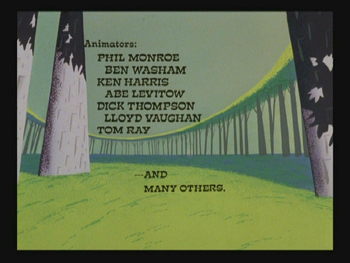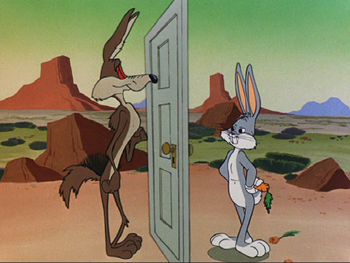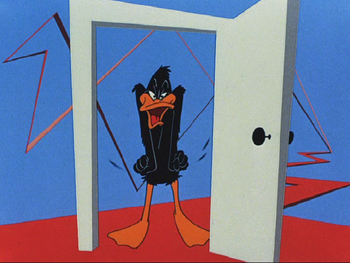 BUY IT AT AMAZON: CLICK HERE!
BUY IT AT AMAZON: CLICK HERE!
STUDIO: Warner Bros.
MSRP: $26.99
RATED: G
RUNNING TIME: 171 Minutes
SPECIAL FEATURES:
• "Young Hollywood: Take On The Looney Tunes" featurette
• "Two Brothers Draw A Looney Tune" featurette
• Animation cel
When I
was a little girl, my Saturday mornings were one great buildup to the Bugs
Bunny and Tweety Show on ABC. I loved the shorts, but I learned to
loathe the stupid claymation that announced the beginning of a new set of
commercials. It seemed as if there were twice as many commercials than there
were cartoons.
For
earlier generations than mine, cartoon shorts were shown as leader to feature
films. Then came television, and the associated opportunities for consumerism,
and who is more susceptible to advertising than children? That’s right: anyone
who bought tickets for Stealth. Other than that? No one. So,
we children of the eighties got to enjoy our Saturday morning rituals liberally
sprinkled with "messages."
This is
why I always made my parents rent The Bugs Bunny/Road Runner Movie
when we made our weekly trips to the video store. Just the thought of an
hour-and-a-half of uninterrupted cartoon hijinks was enough to give me pleasant
dreams. Now, with my older, more critical eye, I still completely identify with
those sentiments of mine. These cartoons were never meant to be segmented over
the air, cut up so that their impossible laws and physical humor were
interspersed with banal songs about "My Buddy," and that tramp,
"Kid Sister."

Gotta have a couple ribs removed.
All of
which is why I ended up writing the longest introductory section of my career.
This is almost the way these cartoons were meant to be seen. They don’t have the commercials, but other sacrifices of time are made, and the individual cartoons suffer for it. Still, these movies have the potential to appeal to deeper senses than nostalgia for your
inner film lover, if you can maneuver your attention past a few blemishes.
The Flicks
Two
ninety-odd minute movies are collected, spread over two discs. The first disc
is dedicated to The Bugs Bunny/Road Runner Movie, which is essentially a
compilation of cartoons thematically linked by chase sequences. It leads off
with a selection of Bugs and Daffy shorts, with Elmer Fudd, Wile E. Coyote, and
Marvin the Martian filling roles as chasers. The movie culminates in almost
twenty straight minutes of Road Runner on Coyote action, which is kind of a
tease because we never get a money shot.
The
second disc is for Bugs Bunny’s 3rd Movie: 1001 Rabbit Tales. The frame story for
this one is a bit more of a stretch. See, Daffy and Bugs both work for Rambling
House publishers. Their boss sends both out to make sales, each to a specific
location, and the one that brings back the best sales figures gets a fine, fine
prize. Bugs is awarded
Eventually, Bugs, with his characteristic knack for getting lost, winds up at
some maharajah’s city, where he plays Scheherazade to a whiny brat. The
episodes that are pulled together for this compilation have less in common with
one another than do the shorts that make up The Bugs Bunny/Road Runner Movie.
Side
note: These things could use catchier titles. I propose Goodbye, My Feet for the
first and The Kid Wore Spectacles for the second.

Poor Mr. Others was teased endlessly in primary school.
The frame
stories of course play second-fiddle to the shorts themselves, and there are
some classics well-represented here. So well-represented, in fact, that a
couple of them overlap. My personal feeling is that you just can’t get enough
of "Hassan chop!" but I could well be in the minority.
To squash
each film down to the requisite length, sections of certain episodes have been
cropped. There are a few glaring omissions, whole swathes removed from familiar
shorts. For example, in "What’s Opera, Doc?" Bugs’ whole backstage
sending for the mail-order earmuffs is removed, and instead he just darts away
from the stage, dons the muffs, and returns. A number of good gags are cut out
in this way. Other small changes are made to dialogue and sound-editing to cram
the episodes into the frame stories. These cuts are rarely invisible, making
scene transitions awkward.
These
changes are minor, for the most part; they do cripple a couple of episodes,
though, so be wary of your familiarity to the material.
Nevertheless,
these samples of silver-age Looney Tunes material remain largely untarnished.
The qualities that make these shorts so entertaining are all well-represented,
here. It’s not the dialogue that you remember (generally), because that drops
into corniness and puns at every opportunity. What sticks these cartoons into
the minds of children and adults alike is the boundless imagination, the way
that universe-bending logic is tossed out like a cough; it’s an effortless
creation of brand new worlds, and I mean that without the slightest sarcasm.
7 out of 10

Despite living in the lowest-rent housing district this side of the Pecos,
Mr. Coyote always kept his pride.
The Look
These
cartoons demand no more than a full-frame presentation. Sure, a master like
attention and detail than you’ll find at a city council meeting, but Looney
Tunes is all about the character, with the set becoming involved only upon
interaction with that character.
The
frames suffer from a lot of noise, especially in the darks, but there are no
wonky, interpolated frames, and all the color looks as if it has been
freshly-dipped.
6 out of 10
The Noise
One of
the major draws of Looney Tunes are the titular tunes, the classical (and
faux-classical) music that the cartoons are synced with. The soundtrack is
presented in glorious mono, but it still sounds all right. The music gets tinny
from time to time, but on a decent system the bottom end holds itself up. It’s
a disappointingly flat soundtrack, in other respects.
There are
a few issues with the sound mixing, as well, particular in Goodbye, My Feet. The
interstitial frames, in which Bugs tours his mansion and describes the concept
of the chase, are mixed with a different reverb on the dialogue. The difference
is so noticeable that, at times, it sounds almost as though a Mel Blanc
impersonator is doing Bugs’ voice.
5 out of 10

"You got your cubism in my sleek modernism!"
The Goodies
One short
documentary accompanies each disc, and they both are complete throwaway
features. On the first disc is "Young Hollywood: Take On The Looney Tunes,"
(which wins my personal award for dumbest placement of a colon) in which a
bunch of child actors reminisce about their favorite cartoons. It makes me
spit. These children grew up in the age of cable. There were always cartoons
on. They didn’t have to base their lives around Saturday morning, treating the
television like a supply of Ketracel-White, as some of we crotchety old
bastards did.
Note: My
bitterness does not affect the score. This feature is also pointless because it
doesn’t contribute anything to the disc that you hadn’t already experienced
watching the flick.
The
second disc features "Two Brothers Draw A Looney Tune". This one is
worth a bit more, but is clearly focused at young people who want to learn how
to draw. It’s not a particularly useful tutorial, but at least it’s fun to
watch familiar characters grow out of their component lines.
Also
included in the package is a collectible animation cel. It’s, uh, nifty.
4 out of 10

"…and the LORD did place invisible guardians at the corners of Eden,
first to fire the Arrows of Retribution at the sons of Adam,
and then, humorously, to trip them into the mud,
whilst accompanying their laughter
on the angelic bowstrings of Arimathea."
The Artwork
Can’t go
wrong with a foiled update on the classic Warner Brothers rings. The cover has
got a nice balance, except for Road Runner’s impetuous head. I just have one
question about little Tweety down there in the corner. There he is, apparently
confronted by a horde of his admirers, and what is he doing? He’s blowing
kisses; he’s blowing kisses to Sylvester.
And Daffy’s hand is resting companionably on Bugs’ shoulder. Is this a kinder,
gentler Daffy, or is he about to push Bugs in front of a limousine?
Surely a
piece of artwork that can summon such questions of interpretation must rate
highly on the ten-point scale.
7 out of 10
Overall 6.6 out of 10